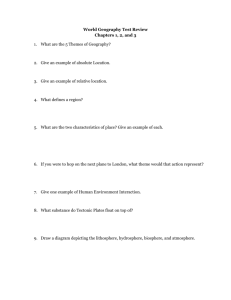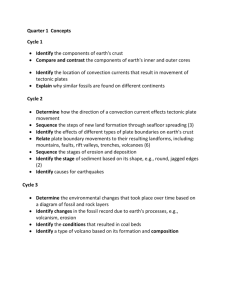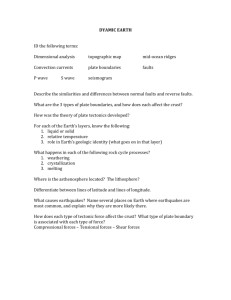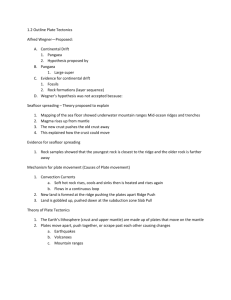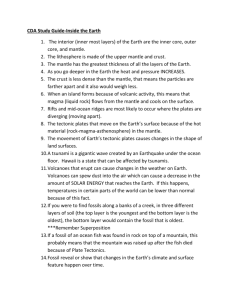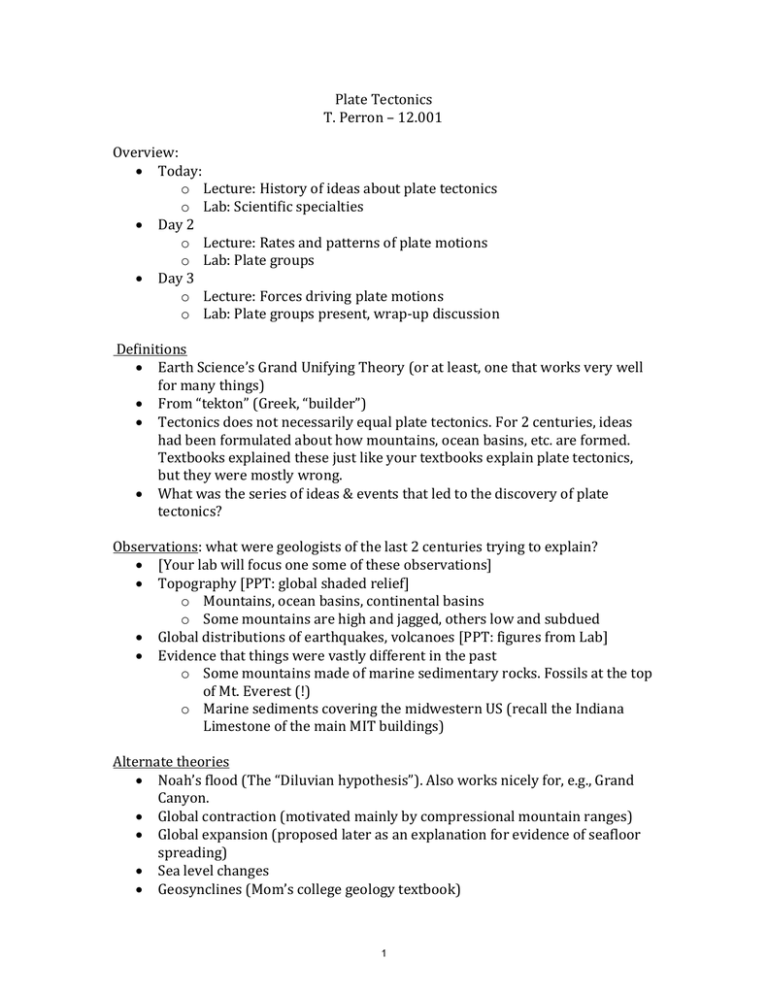
Plate Tectonics
T. Perron – 12.001
Overview:
Today:
o Lecture: History of ideas about plate tectonics
o Lab: Scientific specialties
Day 2
o Lecture: Rates and patterns of plate motions
o Lab: Plate groups
Day 3
o Lecture: Forces driving plate motions
o Lab: Plate groups present, wrap-up discussion
Definitions
Earth Science’s Grand Unifying Theory (or at least, one that works very well
for many things)
From “tekton” (Greek, “builder”)
Tectonics does not necessarily equal plate tectonics. For 2 centuries, ideas
had been formulated about how mountains, ocean basins, etc. are formed.
Textbooks explained these just like your textbooks explain plate tectonics,
but they were mostly wrong.
What was the series of ideas & events that led to the discovery of plate
tectonics?
Observations: what were geologists of the last 2 centuries trying to explain?
[Your lab will focus one some of these observations]
Topography [PPT: global shaded relief]
o Mountains, ocean basins, continental basins
o Some mountains are high and jagged, others low and subdued
Global distributions of earthquakes, volcanoes [PPT: figures from Lab]
Evidence that things were vastly different in the past
o Some mountains made of marine sedimentary rocks. Fossils at the top
of Mt. Everest (!)
o Marine sediments covering the midwestern US (recall the Indiana
Limestone of the main MIT buildings)
Alternate theories
Noah’s flood (The “Diluvian hypothesis”). Also works nicely for, e.g., Grand
Canyon.
Global contraction (motivated mainly by compressional mountain ranges)
Global expansion (proposed later as an explanation for evidence of seafloor
spreading)
Sea level changes
Geosynclines (Mom’s college geology textbook)
1
Continental Drift
Wegener (German meteorologist), post-WWI, Origin of Oceans & Continents:
Continents have moved!
Evidence:
Geographic match (jigsaw) [PPT: relief map]
Rock type match (flood basalts in S. Amer & Africa, old metamorphics in
Canada, Greenland, Scandinavia)
Fossil match (e.g., freshwater reptiles in S. Amer, Africa), followed by
evolutionary divergence of later fossils
Climate evidence (continental glacial deposits in S. Amer, Africa, India,
Australia)
Wegener’s mechanism: Continents are floating on oceanic crust, and move around
like boats due to lunar and solar tides.
Counterarguments
That’s stupid.
This guy is a meteorologist!
Forces are insufficient to overcome huge frictional forces or deform entire
continents. Geologists deferred to physicists.
Even if forces were sufficient, continents would deform internally rather than
drifting
But some stuck with the idea of continental drift, and proposed mechanisms other
than Wegener’s:
Holmes (British), 1920s: Seafloor spreading driven by rising of melt from
Earth’s interior. Didn’t advocate too strongly, for fear of ruining his career.
Evidence mounts
Bathymetric mapping of sea floor [PPT: shaded relief]
o Previously, very little known about what was there
o Mountain ranges in ocean basins. Later found to be continuous along
middle of ocean basins
o Crack-like valley at middle of mountain range (“rift”)
Sampling of seafloor by dredging & drilling
o Seafloor sediments not as thick as previously thought (if ocean basins
4+ Gyr old, should be thicker)
o Oceanic crust made of basalt, not granite
o Younger basalt and sediments near center of ocean basins
Help from the Cold War:
o Mapping magnetic lineations (differences in intensity of field) on
seafloor as by-product of effort to detect submarines post-WWII.
o Symmetric pattern about rifts @ middle of oceans: why? Enigma for
10+ yrs.
2
All these lines of evidence suggest that sea-floor spreading occurs, and that new
crust is created by upwelling of magma at rifts.
But this created a new problem: where does this crust go?
Expanding earth?
Recycling of oceanic crust?
o Lots of geologic action in certain narrow, linear zones on Earth’s
surface…maybe that’s where it’s happening (your lab!)
o Most active deformation (high mountain ranges, young folds, fault
offsets) appears to be occurring at these zones
o [We can now image at least the first stage of oceanic crust being
recycled, using seismic tomography: old cold dense higher
moduli faster wave speed] [PPT: Zhao et al. 1997 Tonga trench]
During the mid-1960s, these observations led geologists to outline the main
principles of plate tectonics:
1. Earth’s outer, rigid layer (“lithosphere”) is broken into discrete plates
(≠continents), each of which moves more or less as a unit. [How many plates
there are is a topic of debate]
2. This motion is accommodated by motion of Earth’s mantle
3. Different types of relative motion and different types of lithosphere @ plate
boundaries create distinctive sets of geologic features (the point of your lab –
more details in our wrap-up discussion on Monday). Why does lithospheric
type matter?
a. Continental lithosphere is less dense not as easily recycled
b. Continental lithosphere is weaker plate boundaries involving
continents are more diffuse
II. Rates and patterns of plate motions
Rates of plate motion: how fast, and how do we know?
A. Geologic evidence
Magnetic anomalies
o Volcanic rock magnetized when cooling
o We can date these rocks radiometrically
o Earth’s magnetic field reverses polarity
o construct global sequence of reversals and their timing (every
~500 kyr on average, but only quasi-periodic)
o Seafloor spreading rate = anomaly width/duration or dist of
reversal from ridge/age of reversal
mid-Atlantic = 18 mm/yr
East-Pacific Rise = 150 mm/yr
Global average = 50 mm/yr
[PPT] Seafloor spreading & magnetic reversals
Age of seafloor sediments from drilling
3
o Foram species change through time, calibrated with dated ash
beds [PPT: foram shells]
Age of offset features
o Volcanic eruptions, e.g., Pinnacles volcanic field: half in central CA,
half near LA
o Radiocarbon dating of organic material in trenches through faults
that have experienced recent EQs [PPT]
B. Direct measurement
Strain meters across faults [SKETCH]
Repeat surveys, e.g. triangulation on Berkeley stadium
Space geodesy
o Satellite laser ranging [PPT] tracks changes in plate locations
relative to precisely known orbits
o VLBI [PPT] tracks phase (and therefore arrival time) difference of
two sites on Earth relative to distant radio sources such as quasars
o GPS (most common): direct measurement of plate motion vectors
with long collection times and careful post-processing [PPT]
Where were plates in the past?
Wegener’s methods
o Geometric matching of plate boundaries
o Fossil matching
o Rock type matching
o Climate indicators in rocks (e.g. glacial deposits, coal beds from
swamps, fossils) give paleo-latitude
Back-tracing seafloor spreading (but oldest oceanic crust ~ 180Ma!)
Back-tracing transform boundaries (but finite range finite time)
Volcanic features that suggest a fixed source in mantle: Hot spots (e.g.,
Hawaii-Emperor seamount chain)
Mountain belts: age, orientation of collision
Geologic indicators of closed plate boundaries
o ophiolites: remnants of oceanic crust that indicate a closed ocean
basin
o Island arcs
o General term for an accreted piece of crust: “terrane”
Paleomagnetism (most powerful)
o Angle of magnetic minerals relative to horizontal latitude
o Longitude is harder; usually no direct constraint
Absolute orientation relative to north, if not too much rotation
has occurred (uncommon, hard to tell)
Multiple samples of same age with known latitude on a single
plate rotation of plate. Again, difficult to get.
Plate motions described by rotation of rigid plate on a sphere about an Euler
pole [PPT]
4
Case studies: [PPT] Movies of plate motions
Breakup of Pangaea (existed ~250Ma): best constraints
[short-lived Pannotia, ~600Ma]
Breakup of Rodinia (existed 1100 - 750 Ma): less well constrained (no
oceanic crust!)
Assembly of Laurentia: Starting with Archean cratons 2Ga. Positions
essentially unconstrained, just relative order and geometry of accretion
Are there any systematic patterns here? How many supercontinents have there
been? J. Tuzo Wilson hypothesized in 1966 that plate tectonics is cyclic [PPT]:
1. Continental rifting (ex: E. Africa)
Image by MIT OpenCourseWare.
2. Formation of seafloor spreading center (ex: Red Sea)
Ocean
Lithosphere
Asthenosphere
Image by MIT OpenCourseWare.
3. Widening ocean basin (ex: Atlantic)
Ocean Crust
Mid-Ocean Ridge
Continental Crust
Image by MIT OpenCourseWare.
4. Initiation of subduction (ex: Pacific Rim)
Subduction zone
Image by MIT OpenCourseWare.
5. Subduction of spreading center (ex: Juan de Fuca Ridge)
Image by MIT OpenCourseWare.
6. Closing of ocean, formation of collisional orogen (ex: closure of Iapetus Ocean
to form the Appalachians, and rocks of the Boston Basin)
5
Continental Collision
Image by MIT OpenCourseWare.
It has been suggested that this cycle takes 300-500 Myr, and controls the formation
and breakup of supercontinents. What forces drive these motions?
III. Driving Forces: Why do plates move?
A sketch of the potentially relevant forces (from Forsythe & Uyeda 1975):
© Oxford University Press. All rights reserved. This content is excluded from our Creative
Commons license. For more information, see http://ocw.mit.edu/help/faq-fair-use/.
Source: Uyeda, S., and D. Forsythe. "On the Relative Importance of the Driving Forces of
Plate Motion." Royal Astronomical Society Geophysical Journal 43 (1975): 163-200.
Force
FDF=mantle drag: could be driving or
resisting
(FCD=possible additional drag on
continents due to different rheology of
asthenosphere)
FRP=ridge push due to gravity
FTF=transform fault friction
FSP=slab pull, gravitational body force
FSR=slab resistance due to viscous drag
FCR=friction between plates
FSU=suction on overriding plate due to
subduction
Driving or Resisting?
D or R, depending on whether mantle
flow assists or opposes plate motion
D or R, same reason as above
D
R
D
R
R
D
A note about mechanical stratification
o What I have drawn here is not crust and mantle – that is a
compositional boundary.
o This is lithosphere vs. asthenosphere – a rheological boundary
Lithosphere includes crust and uppermost mantle, down to
about a few tens to 100 km. Behaves rigidly (brittle at surface)
Asthenes = weak (Greek). Down to 200 or perhaps as much as
400 km. Relatively low viscosity due to high T and perhaps
6
partial melting and the presence of water. Entirely within the
mantle.
Asthenosphere first recognized from low velocity zone in
seismic waves (= low moduli = less rigid), and low viscosities
inferred for uppermost mantle in postglacial rebound studies
What ultimately drives plate tectonics? Mantle convection.
o How do we know this? Heat from Earth’s interior is the only energy
source sufficiently large to move plates. Solar, tides too small.
o The way heat flow is converted into mechanical energy is by
convection. [PPT: Rayleigh-Bénard convection]
Cold boundary layer develops at upper surface of internally
heated fluid. This boundary layer transmits heat conductively
Cold boundary layer sinks due to negative buoyancy
By conservation of mass, this sinking must drive an upward
return flow of hotter material
There will also be a thin thermal boundary layer at lower
surface, which will also be unstable, and can give rise to
positively buoyant plumes (hot spots?)
o But how does it drive plate motion? Which forces are the most
important? For some forces (mainly viscous drag btw lithosphere and
asthenosphere), we aren’t sure of the sign!
Mantle traction
o Viscous drag btw lithosphere and asthenosphere
o Initially assumed to be the main force driving plate motion
o One way to test: plot velocity (in hot spot reference frame) vs. plate
area, because F = stress*area:
o Not much of a relationship! The problem with this is that there are
two interpretations, each consistent with a different argument
7
Plates are strongly coupled to convection cells, so the area
doesn’t matter – the plate velocity is set by convection velocity
The asthenosphere is so weak that plates are almost
completely decoupled from asthenospheric flow, so area
doesn’t matter.
o There are other problems with the idea that mantle traction is the
main, active, driving force:
Why do ridges segment along transforms? Doesn’t make sense
that convection cells would segment that way. Works if the
upwellings under ridges are localized and passive…
Why do ridges sometimes jump positions or start growing in a
new orientation (e.g. East Pac Rise)? Convection cells shouldn’t
do this, but no problem if upwelling is localized and passive.
What happens when a ridge is subducted? Upwelling and
downwelling currents would have to merge! Unless the
upwelling is a localized, passive process…
o These problems led geologists to investigate other potential driving &
resisting forces. If it’s not traction distributed across plate interiors,
maybe it’s forces acting on plate boundaries.
Ridge/rift push
o Gravitational stresses due to thermally elevated region
o Not as strong, but appears to happen
o Intraplate compressional EQs, maybe those in New England
Transform friction
o Resistance at offsets that develop where spreading direction is
oblique to direction of plate motion
o Data:
8
Slab pull
o Sinking of dense, cold oceanic crust pulls plate along
o Data: main difference in velocities is between plates with and without
subduction zones:
o But can’t be the only force, b/c Atlantic wouldn’t have formed and
supercontinents wouldn’t have broken up! Part of the explanation
could be “swell push” from insulated, elevated plate interior. Also
Trench suction?
o Possible mechanisms
1: slab rollback (The wet towel effect)
9
2: secondary convection induced by slab
3: water-induced flux melting thins overlying plate, new ridge
starts to form
o Not clear if it’s important, but could help explain breakup of
supercontinents
So where does mantle traction fit in, if at all? A relevant plot:
o A couple of potential interpretations:
Continents happen to be located on slow plates
Continents slow plates down (deeper roots, more drag?)
o So mantle traction may not be the driver, but mantle drag may be a
non-trivial resisting force, at least under continents
The recognition of these empirical trends was followed up by more rigorous
analyses of the entire system of plates
o Basic assumption: no net torque on individual plates or entire
lithosphere, because they are not accelerating
o Least-squares analysis of relative magnitudes of the forces we’ve
sketched out
Performed simultaneously for all plates
Using no net torque constraint
Using measured plate geometry and velocities as knowns, and
force magnitudes as unknowns
Support idea that slab pull has the largest magnitude
Details of how mechanics of these processes relate to mantle convection &
how the whole system is sustained are still actively studied. E.g., what exactly
is happening in the asthenosphere, and why has it persisted?
Other datasets have been brought to bear in the last 30 years
o Tomography: shows how far down slabs descend
10
o Stress measurements within plates and at plate margins lend support
to the slab pull and ridge push ideas
o Numerical models of mantle convection, though they still have a hard
time incorporating plates (usually just an area of high viscosity), so
it’s hard to just “solve the equations and get it over with”
Note that I haven’t said much about the different types of plate boundaries
and the associated geological features. This is intentional, as it is the subject
of your lab. We’ll cover this in the wrap-up session in the final lab period.
11
Ocean-Continent
Ocean-Ocean
Lab Wrap-Up Discussion
Convergent
S: N/A
V: Narrow chain of
volcanoes on overriding
plate.
E: Narrow band of EQs
becoming deeper in
direction of subduction
[why?].
T: Trench on subducting
plate side, may be island
arc on overriding plate
[why?]. Boundary often
arcuate.
Ex) Aleutian Arc,
Fiji/Tonga, SE Asia
S: N/A
V: Extensive volcanism
on continent side, often
set slightly inland from
coast.
E: Band of EQs becoming
deeper in direction of
subduction [what sets
width of this band?].
T: Trench on subducting
plate side, often
compressional
mountains in addition to
volcanoes on overriding
plate.
Ex) Peru-Chile
S: N/A
V: Sparse.
E: Diffuse EQs in
continental interior.
T: Major mountain
ranges
Ex) India-Asia
Divergent
S: Symmetric, banded
pattern of seafloor age.
Active ridges will have
~zero-age rocks at
center.
V: Submarine volcanism
focused in narrow band.
E: Narrow (~10km
wide) band of shallow
EQs.
T: Elevated ridge with
rift valley at center.
Ex) Mid-Atlantic, East
Pacific, SW India
Transform
S: Asymmetric pattern.
V: Sparse, unless there is
a subduction
component.
E: Many shallow,
centered on boundary.
T: May be
compressional
mountains; otherwise
no clear signature.
Ex) New Zealand,
Caribbean
N/A
S: N/A
V: Sparse, unless there is
a subduction
component.
E: Many shallow,
centered on boundary.
T: May be
compressional
mountains; otherwise
no clear signature.
Ex) N. America-Pacific
S: N/A
V: Sparse.
E: Many shallow,
centered on boundary.
T: May be
compressional
mountains; otherwise
no clear signature.
Ex) Turkey; Eurasia-N.
America?
S=seafloor age, V=volcanoes, E=earthquakes, T=topography
Continent-Continent
S: N/A
V: Abundant volcanism,
often associated
E: Diffuse, shallow EQs.
T: Broad, elevated
region with major rift
valley.
Ex) E. Africa
12
MIT OpenCourseWare
http://ocw.mit.edu
12.001 Introduction to Geology
Fall 2013
For information about citing these materials or our Terms of Use, visit: http://ocw.mit.edu/terms.

